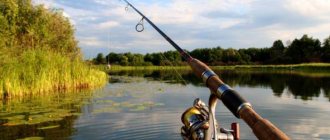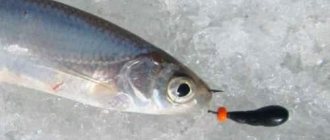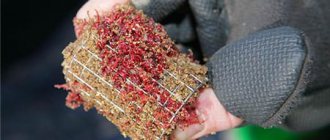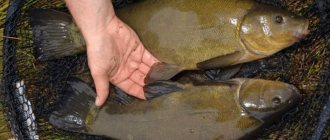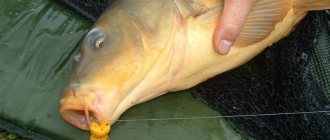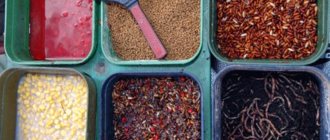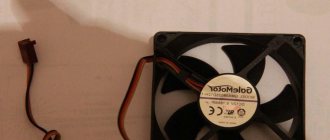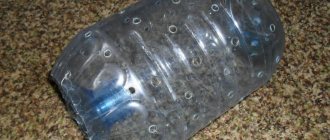Where and when to catch ide
The ide bites best in late May and early June. As for the places to catch it, the best places will be areas of the reservoir where the current is very quiet and the depth is no more than two meters. Typically, ide swims under various snags, piles, bridges and banks with steep cliffs. If the catch takes place in large lakes and reservoirs, then you should look for ide there in dense thickets of reeds, which have underwater holes and sharp changes in depth.
Catching ide has the following features:
- You can catch ide with a float rod from early spring until the beginning of winter.
- The ide bites from early morning until sunset. Like most fish, ide is most active before dawn. But there are cases when an ide was caught in the middle of the night while it was feeding.
- The ide is a rather strong and stubborn fish. This should be remembered when fishing it. At first it violently pulls away from the hook, and at this moment you should not rush and pull it out, since it can break the line. It’s better to exhaust it a little so that the fish moves away and only then, using a landing net, pull the ide out to the coastal zone.
- When fishing for ide, you should be as quiet as possible and not make sharp sounds, as they can scare away the fish. In addition, the fisherman must wear special camouflage clothing, since ide is very susceptible to harsh colors.
Biting calendar
| January | February | March | April | May | June |
| — | — | — | + | +++ | + |
| July | August | September | October | November | December |
| +++ | +++ | +++ | + | — | — |
Despite the year-round life cycle of ide, a good bite is not observed in all seasons.
The best time for fishing is considered to be the post-spawning period in May. The ide actively feeds, restoring strength after spawning. A good bite occurs during the period when the cockchafer and dragonfly emerge.
Groundbait for ide
The following ingredients should be used as bait for catching ide:
Pearl barley porridge is one of the best baits for ide, as it is easy to prepare and very effective. It should be used in bodies of water with strong currents. You need to cast in small portions, otherwise the fish will quickly get enough and will not pay attention to the bait.

Cake made from flax and hemp grains is also a very effective bait. They are used mixed with clay. To do this, mix the cake with clay and roll into small balls. You need to cast into those parts of the reservoir that have a good current. The stronger the flow of water, the larger these balls should be, but they should not be larger than a fist.

Often, ground crackers (homemade), powdered milk, worms, rolled oats porridge and bloodworms are used for bait. These ingredients should be made into a homogeneous mass and also rolled into balls. In addition, you can add a little cake or sunflower oil to them, which will add a little more flavor. At the same time, you should ensure that the finished bait balls are not very fragile and do not break when falling to the bottom of the reservoir. Let them be firmer and stickier.

The process of feeding ide is as follows:
- The fisherman scatters the bait over a certain distance, or the so-called “bait corridor”. The ide does not often immediately swim up to the bait, since roach and bleak are almost always ahead of it in this matter. Only after some time does the ide swim closer to the feeding area and begin to take an interest in it.
- If the bait mixture contains components only of plant origin, then they can be used in spring and summer. If it contains animal ingredients (worms, maggots, bloodworms), then this complementary food is best used in late summer and autumn.
- In addition, instead of bait balls, the finished mixture of bait can be laid out in a small net with well-marked cells and lowered over the side of the boat. The mixture will gradually be washed out with water, and a trail of fish will be drawn behind the boat. This is a fairly effective way to attract ide. To ensure that the bait mixture does not wash out so quickly, it should be made in the form of tight balls and a little clay should be added to them.
- If complementary feeding is carried out from the shore, it should be thrown into the growth zones of aquatic grass or bushes, which are located on coastal areas in the water. You can also throw individual ingredients directly into the water so that they simply drift away with the current. For this you can use boiled peas, rolled oats or boiled wheat.
- In the winter and autumn seasons, various protein supplements, which are usually used for catching carp, should be mixed into complementary foods. They are great at attracting ide too.
Bait recipes for carp and carp
Catching carp and carp requires special bait.
To prepare it you need to do the following:
- At the same time, cook a mixture of the following porridges : wheat, corn, peas and barley. Remember that the porridge must be stirred often, otherwise the desired mixture will not work out. In addition, if you do not mix the porridge, then its consistency will not correspond to the desired one.
- Cool the mixture naturally, but with the lid closed.
- After cooling, add sunflower seed cake.
- After everything has been mixed, add 200 grams of semolina or millet.
There is another very popular recipe. The porridge is cooked in the same way as described above, but without peas and pearl barley.
To the resulting mixture you must add:
- 700 grams of oatmeal cookies;
- 500 grams of baked milk cookies;
- 300 grams of ground peanuts.
Recommendations for choosing a fishing method depending on the season and place of fishing
- If the water in the reservoir is cloudy and the fisherman has the ability to camouflage himself, then he should use a float rod, since in clear water the ide will quickly be able to understand the threat.
- To catch ide from a boat, it is better to use a rod with a sliding rig.
- In those areas of the reservoir where there is a lot of algae and other vegetation, it is recommended to use bottom tackle.
- If you are going to catch large ide at a long distance, then it would be wiser to use a spinning rod, since it is the most powerful and reliable.
- For fishing in the dark seasons (spring and summer), it is better to use a float rod. For fishing during cold periods (autumn and winter), you should use a spinning rod or bottom tackle.
Lures
In winter , ide is caught on:
- bloodworm
- bark beetle
- grandma
- burdock moth larva
- vertical lure of the “clove” type
In spring it bites well on:
- caddisfly
- worm
- small spinners
Closer to summer, the surface fishing season begins on:
Excellent baits from summer to late autumn are:
Among the artificial baits that work well are:
Catching ide with a fishing rod
Catching ide with a fishing rod requires special preparation. The first thing you should take care of is the gear used.
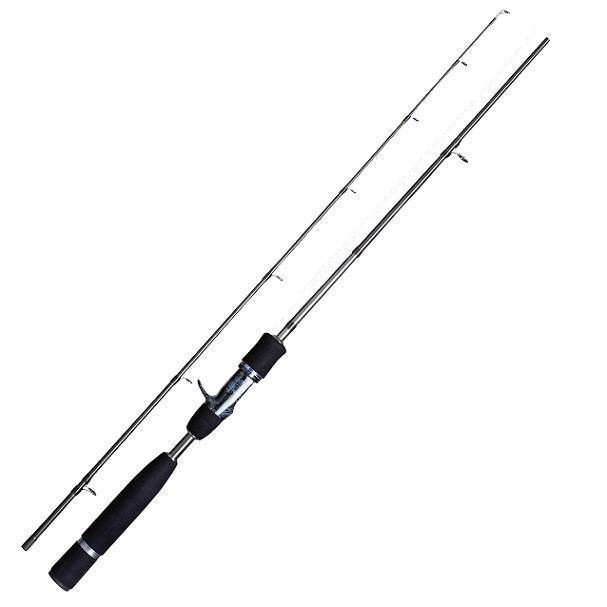
They should be like this:
- Float rod. Its length should be from seven to nine meters.
- The equipment should be “deaf”, since with a large fishing rod the reel will get in the way.
- Main line. It should be 0.15 mm in diameter. If the line is thicker than this size, the process of immersing it in water will take much longer, which is impractical.
- Hooks should be selected according to the attachment used. The main requirement for them is their hardness and reliability, since ide is a very strong fish and can easily break low-quality hooks.
- For leashes, monofilament with a diameter of 0.14 mm should be used.
- The float should not be a very bright color with a shape similar to a pear. The length of its keel should be about twenty-five centimeters.
- The weights must be olive-shaped and weigh the entire fifty grams.
The following components should be used as bait for catching ide on a fishing rod:
- Worms.
- Maggot.
- Insects (for catching in summer).
- Caddisfly larvae.
- Dough.
- Pearl barley.
- Steamed wheat.
- Steamed peas.
The process of catching ide with a fishing rod has the following features:
- The best places for catching ide with a float rod are considered to be areas of a reservoir with a very quiet current and a depth of no more than one and a half meters. It is advisable to fish near various snags, under trees growing near the water or near bridges.
- The ide bite on a float rod is usually active, but short-lived. In addition, it can often be confused with the bite of small fish (bleak or perch).
- When fishing with a float rod, you should hook the ide very quickly, but not too sharply, so that the tackle does not break.
- The ide should be caught from below with a landing net so that the fish cannot dodge.
Spinning fishing
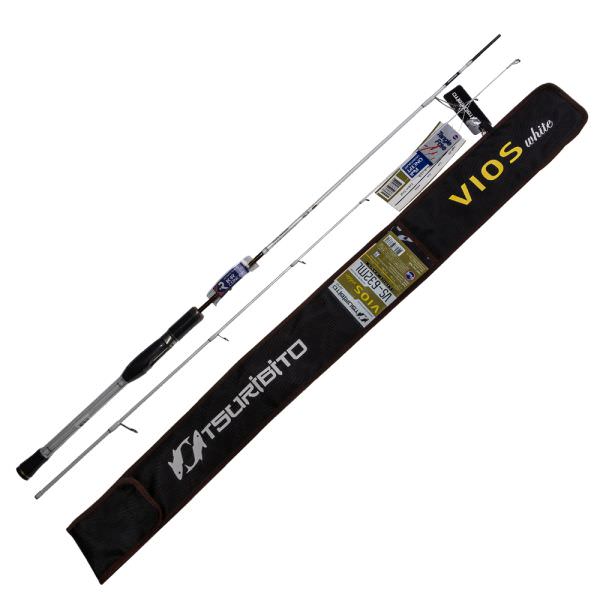
To catch ide with a spinning rod, you should prepare the following gear:
- The fishing rod is light with dough from two to fifteen grams and two and a half meters long. It must have a fast action and be very rigid and durable.
- The fishing line should be 0.2 mm in diameter. It is advisable to use braided wire.
- The reel should have size 2500 bobbins.
- The hook is suitable number 5. It must be of excellent quality and have a sharp sting.
The following components should be used as bait:
- Sandwich made from maggot and pearl barley.
- Leeches.
- Worms.
- Peas.
- Artificial baits (wobblers).
The process of catching ide with a spinning rod has the following features:
- It should be cast into places with an uneven bottom and changes in depth.
- Posting artificial baits should be done at half-water, no more than one and a half meters from the surface.
- After casting the bait, you should make a short stop so that the wobbler can drop to the required water level. After this, you need to do a slow retrieve, which attracts the ide’s attention better than a fast one.
- The ide bites slowly and you should have very sensitive tackle. To recognize his kicks.
- You need to hook deftly, otherwise if the fisherman doesn’t succeed in hooking quickly, he will need to reel in the catch, which is not always easy.
Pea bait: float + long cast
One of the simplest baits is pea bait. Its preparation does not require a large number of ingredients, and it is also easy to prepare. In addition, pea bait can be used both for fishing with a float and for long casts.
In order to prepare bait from pea porridge for fishing you need:
- Take 1 kg of pea porridge and fill it with cold water. The fact is that if you put peas in cold water for 3-4 hours, they will absorb all the water, swell and cook much faster. Remember that you should not use tap water to prepare bait. The fact is that it contains a high content of bleach, and it has a specific smell that will repel fish.
- Put it on the stove to cook . When doing this, do not forget to stir and also monitor the foam. When cooked, pea porridge forms a large amount of foam. Therefore, it is better to clean it periodically so that there are no problems with cooking and cleaning afterwards.
- After cooking and cooling, we sort the resulting porridge into bags and put it in the freezer. From there the bait will go straight to fishing.
Catching ide on a feeder

To catch ide on a feeder, you should use the following gear:
- A powerful rod for fishing on a feeder with a length of no more than eight meters.
- Main line with diameters of 0.26-0.30 mm.
- Lightweight cage-shaped feeders.
- Hooks No. 8.
- The tackle is a symmetrical loop.
The following devices should be used as bait:
Spoons. They show very good results for catching ide. It is recommended to use spinners with size 2. They should be white or spotted in color, since ide usually feeds on spotted fry. Also, if the ide bites weakly, then you can use red or yellow spoons. The most important thing in a spinner is that it performs well when retrieved.
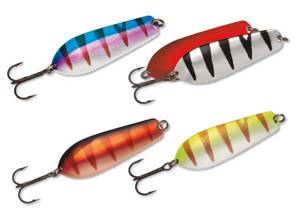
Wobblers. They should be small in size and natural in color. It is desirable that the wobblers move well even with very slow wiring and make a small noise that attracts ide.

The process of catching ide on a feeder has the following features:
- It is best to catch ide on a feeder in the autumn. The best places for fishing will be shallow areas of reservoirs with a quiet current. In such places, the water is quite clean and the ide will not let you get too close, so using a feeder fishing rod will be very convenient.
- It is advisable to use steamed peas with flour and rolled oats as bait for feeders. You can also add finely chopped worms or bloodworms to this mixture.
- Feeder fishing is most effective in the morning and late evening.
- The feeder rod should have a very soft tip.
- The bite of an ide with such a fishing rod is quick and short, so the angler must always be ready to hook.
- When nursing an ide, it is advisable to work quickly, but carefully, so as not to lose the catch, which can tear the gear or its lip.
- You should not rely only on your own strength and do without a landing net. For catching ide, this is an integral element of the gear.
Recipes for spring
In the spring, catching ide can also be successful, you just need to choose the right time for fishing, because it is in the spring that it, like many other species of fish, begins its spawning period, during which one cannot count on a good result. But before and after spawning, spring fishing can be quite successful.
Important! In the spring you need to be careful with the amount of bait; if there is too much of it, you can overfeed the fish at the point, and then there will be neither a bite nor a catch.
The recipes are often quite simple. In the spring, the following mixture may well work:
- Pearl barley porridge.
- Chopped worm.
- Clay, or soil from a pond.
Instead of a worm in this composition, you can use maggots or bloodworms. You can add flavoring if you wish. Pea-based mixtures can also work well. The presence of soil in spring bait for ide is due to the fact that during this period it is quite easy to overfeed it, and soil from a reservoir or clay not only prevents early saturation, but also changes the color of the bait, which is especially important in the case of this cautious fish.
Other fishing methods
It is also possible to catch ide while fishing.
To do this you should use the following gear:
- A lightweight but durable fishing rod with a length of four meters.
- Lead reel, which is strengthened in the lower area of the butt.
- A line with a diameter of 0.23 mm and a length twice as long as the length of the rod.
It is better to use a fishing line from a boat, since with its help it is much easier to find the right place to catch ide, and besides, this fish is not very afraid of the sight of a boat.
Fishing in wiring is carried out in this way:
- First you need to choose a place. The best zone is considered to be a reservoir with medium current pressure and a clay or sandy bottom. The depth should be no more than two and a half meters.
- Having chosen a place, you should throw in the bait that fills the feeder. To do this, mix various cereals, crackers and clay into a homogeneous mass. Feeders with bait mixture should be placed half a meter from the bottom of the reservoir.
- Then you should throw the nozzle and start retrieving it. During this process, you should raise the bait slightly above the bottom several times to further attract the fish.
- You should hook quickly and firmly so that the ide does not have time to escape from the hook.
- If the catch takes place in a large current, then the ide should not be fished very quickly, but not too slowly either. You just need to act in a coordinated manner, without flailing around the boat and without panicking.
- You can catch ide in this way from early spring to autumn.
There is another way to catch ide, which is called jig fishing. It is used exclusively in large currents of the reservoir.
To fish in this way, you should use the following gear:
- A fishing rod with a length of five meters and a sensitive tip.
- Reel (spinless) with spool size 2000.
- Line with a diameter of 0.22 mm.
The catch goes like this:
- A jig with a nozzle is immersed in the water near the side of the boat.
- In a high current, the nozzle will immediately land on the very bottom.
- The fishing line must be kept taut at all times.
- The fisherman moves the fishing rod, making small pauses.
- When the ide begins to bite, it is immediately noticeable by the characteristic bend of the rod tip. In addition, you can feel it with the hand you are holding the tackle with.
- Hooking should be done smoothly, as fast hooking can break the rod tip.
